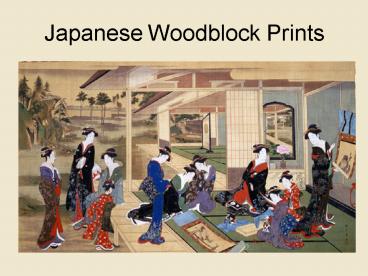Japanese Woodblock Prints - PowerPoint PPT Presentation
1 / 10
Title:
Japanese Woodblock Prints
Description:
The Japanese Edo period was the height of block-making. ... A Beauty. This print shows a beautiful woman. She's wearing a kimono, a traditional Japanese dress. ... – PowerPoint PPT presentation
Number of Views:1622
Avg rating:3.0/5.0
Title: Japanese Woodblock Prints
1
Japanese Woodblock Prints
2
Ancient Roots
- Woodblock prints were first used in Japan around
700 AD. The technique was brought to Japan by
Chinese Buddhist monks. The original works, like
the one pictured above, were religious text.
Buddha is depicted with a halo in this work.
3
Technique
- Woodblocks are made by carving a scene into a
block of wood, then coating the block with ink
and pressing it--inside down--on paper. - For the first 1000 years, wood block prints were
printed in only one color--black, though
occasionally were hand-tinted after pressed. - When pressed, the image is reversed on the paper.
4
Color Printing
- As hand-tinting became more popular, printers
moved to hiring expert carvers to make color
blocks so more prints could be made of each
image. - Each color to be printed required a separate
block. Finer prints might have as many as 15
separate colors--and thus 15 different blocks
were carved to make a single print. - The advantage was that each block could be used
over and over again, allowing multiple prints to
be made. - The blocks required great precision, as each
color section had to match exactly.
5
The Great Wave at Kanagawa
- This is one of the most famous Japanese
woodblocks. The hill in the back is Mt. Fuji.
Try to count the number of colors used.
6
Edo Period1615-1868
- The Japanese Edo period was the height of
block-making. - The new block method made prints widely
available. As a result, the subjects of the
prints became much broader to appeal to a general
taste, not just to the rich. Celebrities, travel
sites, military heroes, beauties, and genre
scenes played roles in the popular art form. - This is a print of two popular actors shown in
character.
7
A Beauty
- This print shows a beautiful woman. Shes
wearing a kimono, a traditional Japanese dress.
The variety and richness of prints in her kimono
show her status, as does the servant that follows
behind her. The servant has his hair cut in a
queue, or a topknot. - Only certain woods were allowed to be used for
carving, and then only if the grain was right.
Imagine the intricate cuts needed to carve the
black print fabric and the shading on her gowns.
8
Yoko Protecting his Father
- Count how many blocks would be needed here!
- Notice the boy in the red jacket protecting his
elderly father from the tiger prowling on the top
left. - Does this print make you think of a comic book?
Does the tiger seem real or larger than life?
9
Edo Period
- Edo, the ancient name of the city of Tokyo, is
also the name given to the 250 year time period
where samurai ruled Japan. They shut Japan off
from foreign contact, looking inward for their
needs. - The art of Edo woodblocks is called ukiyo-e,
which means pictures of the floating world, a
reference to Japan. - This print is of a samurai, shown in armor, but
without his helmet.
10
Views of Edo
- When Japan opened up to the West in 1865, the
woodblock prints had a great impact on western
artists. - Van Gogh, Morisot, and other painters of the age
included the prints in their works and were
influenced by the gorgeous color and lines in the
works. - How many colors can you count in this work? Does
the bridge look like bridges you have used?

